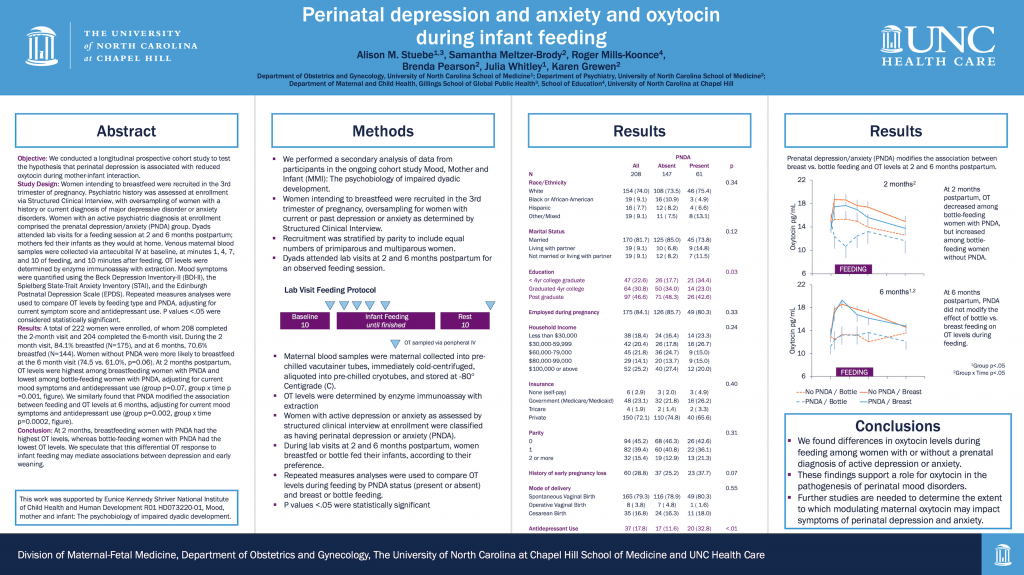Presented at the Society for Maternal Fetal Medicine, Las Vegas, NV, February 2019
Alison M. Stuebe, Samantha Meltzer-Brody, Roger Mills-Koonce, Brenda Pearson, Julia Whitley, Karen Grewen
Objective: We conducted a longitudinal prospective cohort study to test the hypothesis that perinatal depression is associated with reduced oxytocin during mother-infant interaction.
Study Design: Women intending to breastfeed were recruited in the 3rd trimester of pregnancy. Psychiatric history was assessed at enrollment via Structured Clinical Interview, with oversampling of women with a history or current diagnosis of major depressive disorder or anxiety disorders. Women with an active psychiatric diagnosis at enrollment comprised the prenatal depression/anxiety (PNDA) group. Dyads attended lab visits for a feeding session at 2 and 6 months postpartum; mothers fed their infants as they would at home. Venous maternal blood samples were collected via antecubital IV at baseline, at minutes 1, 4, 7, and 10 of feeding, and 10 minutes after feeding. OT levels were determined by enzyme immunoassay with extraction. Mood symptoms were quantified using the Beck Depression Inventory-II (BDI-II), the Spielberg State-Trait Anxiety Inventory (STAI), and the Edinburgh Postnatal Depression Scale (EPDS). Repeated measures analyses were used to compare OT levels by feeding type and PNDA, adjusting for current symptom score and antidepressant use. P values <.05 were considered statistically significant.
Results: A total of 222 women were enrolled, of whom 208 completed the 2-month visit and 204 completed the 6-month visit. During the 2 month visit, 84.1% breastfed (N=175), and at 6 months, 70.6% breastfed (N=144). Women without PNDA were more likely to breastfeed at the 6 month visit (74.5 vs. 61.0%, p=0.06). At 2 months postpartum, OT levels were highest among breastfeeding women with PNDA and lowest among bottle-feeding women with PNDA, adjusting for current mood symptoms and antidepressant use (group p=0.07, group x time p =0.001, figure). We similarly found that PNDA modified the association between feeding and OT levels at 6 months, adjusting for current mood symptoms and antidepressant use (group p=0.002, group x time p=0.0002, figure).
Conclusion: At 2 months, breastfeeding women with PNDA had the highest OT levels, whereas bottle-feeding women with PNDA had the lowest OT levels. We speculate that this differential OT response to infant feeding may mediate associations between depression and early weaning.

